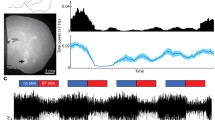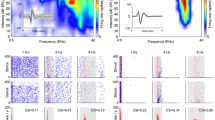Abstract
The activity of 52 single auditory units in the central nucleus of the inferior colliculus (IC) was recorded along with cortical and hippocampal (CA1) electrograms and neck muscle electromyograms in behaving, head-restrained guinea pigs during paradoxical sleep (PS) and wakefulness. Sixteen (30%) of the IC auditory units showed positive correlation with the hippocampal theta (θ) rhythm: 8 (15%) were θ rhythmic with θ phase-locking (type 1), 8 (15%) showed only θ phase-locking with no rhythmicity (type 2), while 70% did not show any correlation to hippocampal θ rhythm (type 3). During wakefulness IC neurons (4 of 13) showed a higher synchrony with hippocampal θ when sound-stimulated at the unit's characteristic frequency. During PS all IC auditory neurons recorded presented some hippocampal θ correlation: 40% were rhythmic and phase-locked to the θ frequency and 60% were nonrhythmic maintaining the θ phase-locking. Shifts in the angle of phase-locking to the θ rhythm were observed during PS. It is suggested that the hippocampal θ rhythm may play the part of an internal clock, adding a temporal dimension to the processing of auditory sensory information.
Similar content being viewed by others
References
Bland BH (1986) The physiology and pharmacology of hippocampal formation theta rhythms. Prog Neurobiol 26:1–54
Bruneau N, Roux S, Guerin P, Garreau B, Lelord G (1993) Auditory Stimulus intensity responses and frontal midline theta rhythm. Electroencephalogr Clin Neurophysiol 86:213–216
Buño W, Velluti JC (1977) Relationship of hippocampal theta cycle with bar pressing during self-stimulation. Physiol Behav 19:615–621
Cazard P, Buser P (1963) Modification des résponses sensorielles corticales par stimulation de l'hippocampe dorsal chez le lapin. Electroencephalogr Clin Neurophysiol 15:413–425
Destrade C (1982) Two types of diencephalically driven RSA (theta) as a means of studying memory formation in mice. Brain Res 324:486–493
Domesick VB (1969) Projections from the cingulate cortex in the rat. Brain Res 12:296–320
Fuentes J, Buño W, García-Austt E (1981) Simulation of post-synaptic activities in hippocampal cells during theta rhythm. Brain Res Bull 7:157–162
García-Austt E (1984) Hippocampal level of neural integration. In: Ajmone-Marsan E, Reinoso-Suárez F(eds) Cortical integration. Basic archicortical and cortical association levels of neuronal integrations. (IBRO monograph series) Raven, New York, pp 91–104
García-Sánchez JL, Buño W, Fuentes J, García-Austt E (1978) Non-rhythmical hippocampal units, theta rhythm and afferent stimulation. Brain Res Bull 3:213–219
Gaztelu JM, Romero-Vives M, Abraira V, Garcfa-Austt E (1994). Hippocampal EEG theta power density is similar during slow-wave sleep and paradoxical sleep. A long-term study in rats. Neurosci Lett 172:31–34
Green JD, Arduini AA (1954). Hippocampal electrical activity in arousal. J Neurophysiol 17:403–420
Kocsis B, Vertes RP (1992) Dorsal raphe neurons: synchronous discharge with the theta rhythm of the hippocampus in the freely behaving rat. J Neurophysiol 68:1463–1467
Kocsis B, Vertes RP (1994) Characterization of neurons of the supramammillary nucleus and mammillary body that discharge rhythmically with the hippocampal theta rhythm in the rat. J Neurosci 14(11):7040–7052
Kramis RC, Vanderwolf CH, Bland BH (1975) Two types of hippocampal rhyhmical slow activity in both the rabbit and the rat. Relations to behavior and effects of atropine, diethylether, uretane and pentobarbital. Exp Neurol 49:58–85
Lerma J, García-Austt E (1985) Hippocampal theta rhythm during paradoxical sleep. Effects of afferent stimuli and phase-relationships with phasic events. Electroencephalogr Clin Neurophysiol 60:46–54
Lopes da Silva FH, Witter MP, Boeijinga PH, Lohman AHM (1990) Anatomical organization and physiology of the limbic cortex. Physiol Rev 70:453–511
McNaughton BL, Morris RGM (1987) Hippocampal synaptic enhancement and information storage within a distributed memory system. Trends Neurosci 10:408–415
Monmaur P, Houcine O, Delacour J (1979) Experimental dissociation between wakefulness and paradoxical sleep hippocampal theta. Physiol Behav 23:471–479
Morales-Cobas G, Ferreira MI, Velluti RA (1995) Sleep and waking firing of inferior colliculus neurons in response to low frequency sound stimulation. J Sleep Res 4:242–251
Parmeggiani PL, Rapisarda C (1969) Hippocampal output and sensory mechanisms. Brain Res 14:387–400
Parmeggiani PL, Lenzi P, Azzaroni A, D'Alessandro R (1982) Hippocampal influence on unit responses elicited in the cat's auditory cortex by acoustic stimulation. Exp Neurol 78:259–274
Pedemonte M, Peña JL, Morales-Cobas G, Velluti RA (1994). Effects of sleep on the responses of single cells in the lateral superior olive. Arch Ital Biol 132:165–178
Peña JL, Pedemonte M, Ribeiro MF, Velluti RA (1992) Single unit activity in the guinea pig cochlear nucleus during sleep and wakefulness. Arch Ital Biol 130:179–189
Radmilovich M, Bertolotto C, Peña JL, Pedemonte M, Velluti RA (1991) A search for a mesencephalic periaqueductal gray-cochlear nucleus connection. Acta Physiol Pharmacol Latinoam 41:369–375
Rawlins JNP (1985) Associations across time in the hippocampus as a temporary memory store. Behav Brain Sci 8:479–496
Redding FK (1967) Modification of sensory cortical evoked potentials by hippocampal stimulation. Electroencephalogr Clin Neurophysiol 22:74–83
Romansky LM, Ledoux JE (1993) Information cascade from primary auditory cortex to the amygdala-corticocortical and corticoamygdaloid projections of temporal cortex in the rat. Cereb Cortex 3:515–532
Velluti RA, Pedemonte M, García-Austt E (1989). Correlative changes of auditory nerve and microphonic potentials throughout sleep. Hearing Res 39:203–208
Vertes RP (1981) An analysis of ascending brain stem systems involved in hippocampal synchronization and desynchronization. J Neurophysiol 46:1140–1159
Vertes RP (1982) Brain stem generation of the hippocampal EEG. Prog Neurobiol 19:159–186
Author information
Authors and Affiliations
Rights and permissions
About this article
Cite this article
Pedemonte, M., Peña, J.L. & Velluti, R.A. Firing of inferior colliculus auditory neurons is phase-locked to the hippocampus theta rhythm during paradoxical sleep and waking. Exp Brain Res 112, 41–46 (1996). https://doi.org/10.1007/BF00227176
Received:
Accepted:
Issue Date:
DOI: https://doi.org/10.1007/BF00227176




